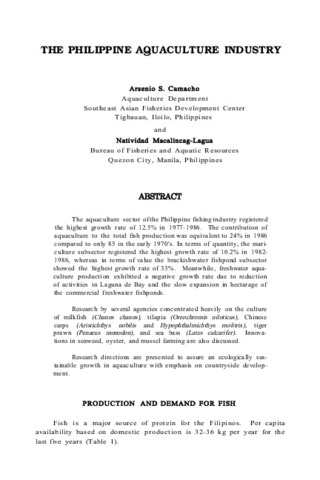Antibacterial metabolites in the microbial and phytoplankton flora of the "green water" culture of shrimp (Penaeus monodon): Part II. Fish mucus and luminous Vibrio
| dc.contributor.author | Lio-Po, Gilda D. | |
| dc.contributor.author | Franco, Annie | |
| dc.contributor.author | Peñaranda, Ma. Michelle D. | |
| dc.contributor.editor | Nagasawa, Kazuya | |
| dc.date.accessioned | 2020-07-22T02:10:23Z | |
| dc.date.available | 2020-07-22T02:10:23Z | |
| dc.date.issued | 2005-03 | |
| dc.identifier.citation | Lio-Po, G. D., Villa-Franco, A. U., & Peñaranda, M. M. D. (2005). Antibacterial metabolites in the microbial and phytoplankton flora of the "green water" culture of shrimp (Penaeus monodon): Part II. Fish mucus and luminous Vibrio. In K. Nagasawa (Ed.), Recent Advances in Diagnosis and Prevention of Fish and Shrimp Diseases in Southeast Asia (pp. 177–182). Tigbauan, Iloilo, Philippines: Aquaculture Department, Southeast Asian Fisheries Development Center. | en |
| dc.identifier.isbn | 9718511732 | |
| dc.identifier.uri | http://hdl.handle.net/10862/5925 | |
| dc.description.abstract | Experiments on the presence of anti-luminous Vibrio properties in marine fish species cultured in the Philippines, i.e., jewel tilapia (Oreochromis hornorum), red tilapia (hybrid of Oreochromis niloticus and O. mossambicus), milkfish (Chanos chanos), grouper (Epinephelus spp.), rabbitfish (Siganus gutattus), sea bass (Lates calcarifer) and red snapper (Lutjanus argentimaculatus) were conducted. Assays revealed that the mucus of rabbitfish and jewel tilapia, compared with the other test fishes, did not have any resident luminous bacteria. Exposure of luminous Vibrio to the epidermal mucus of rabbitfish, jewel tilapia, red tilapia, sea bass, red snapper and milkfish showed that the inoculated bacterial pathogen can be inhibited or reduced. The skin mucus of rabbitfish exerted an almost immediate bactericidal effect on the test bacteria, followed by red tilapia, sea bass and jewel tilapia skin mucus that induced a rapid reduction in <3 hr and 6 hr or 24-48 hr when inoculated with 101-3 cfu/mL or 105 cfu/mL luminous Vibrio, respectively. Red snapper and milkfish mucus, inhibited the luminous Vibrio in 24 hr and 48/96 hr, respectively. Only the skin mucus of grouper did not show any antagonistic effect on the test Vibrio. This study confirms the presence of varying potencies of anti-luminous Vibrio substances on the skin mucus of some marine fish and provides a guide on the choice of fish to use in the “green water culture technique” for preventing luminous vibriosis in the grow-out culture of black tiger shrimp (Penaeus monodon). | en |
| dc.language.iso | en | en |
| dc.publisher | Aquaculture Department, Southeast Asian Fisheries Development Center | en |
| dc.subject | Vibrio | en |
| dc.subject | Oreochromis mossambicus | en |
| dc.subject | Chanos chanos | en |
| dc.subject | Epinephelus | en |
| dc.subject | Siganus guttatus | en |
| dc.subject | Lates calcarifer | en |
| dc.subject | Lutjanus argentimaculatus | en |
| dc.subject | Penaeus monodon | en |
| dc.title | Antibacterial metabolites in the microbial and phytoplankton flora of the "green water" culture of shrimp (Penaeus monodon): Part II. Fish mucus and luminous Vibrio | en |
| dc.title.alternative | Part II. Fish mucus and luminous Vibrio | en |
| dc.type | Book chapter | en |
| dc.citation.spage | 177 | |
| dc.citation.epage | 182 | |
| dc.citation.bookTitle | Recent Advances in Diagnosis and Prevention of Fish and Shrimp Diseases in Southeast Asia | en |
| dc.subject.asfa | mucus | en |
| dc.subject.asfa | vibriosis | en |
| dc.subject.asfa | shrimp culture | en |
| dc.subject.asfa | pathogens | en |
| dc.subject.asfa | fish skin | en |
| dc.subject.asfa | luminous organisms | en |
| dc.subject.asfa | fish culture | en |
| dc.subject.scientificName | Penaeus monodon | en |
| dc.subject.scientificName | Oreochromis hornorum | en |
| dc.subject.scientificName | Chanos chanos | |
| dc.subject.scientificName | Lates calcarifer | en |
Files in this item
This item appears in the following Collection(s)
-
Recent Advances in Diagnosis and Prevention of Fish and Shrimp Diseases in Southeast Asia [43]
Terminal Report of the Regional Fish Disease Project on “Development of Fish Disease Inspection Methodologies for Artificially-Bred Seeds” Funded by the Government of Japan Trust Fund from 2000 to 2004


 AQD Access only
AQD Access only


